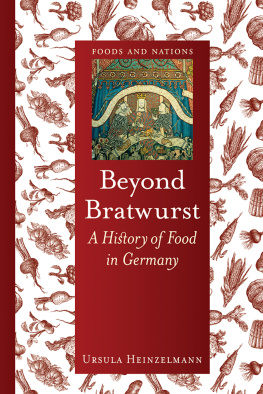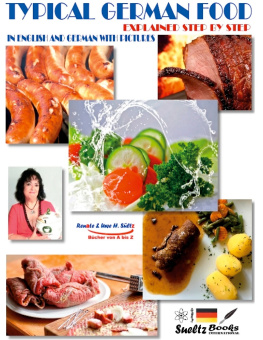BEYOND BRATWURST

FOODS AND NATIONS is a new series from Reaktion that explores the history and geography of food. Books in the series reveal the hidden history behind the food eaten today in different countries and regions of the world, telling the story of how food production and consumption developed, and how they were influenced by the culinary practices of other places and peoples. Each book in the Foods and Nations series offers fascinating insights into the distinct flavours of a country and its culture.
Already published
Al Dente: A History of Food in Italy
Fabio Parasecoli
Beyond Bratwurst: A History of Food in Germany
Ursula Heinzelmann
Beyond
Bratwurst

A History of Food
in Germany
U RSULA H EINZELMANN
REAKTION BOOKS
To Barbara, Darra and Elisabeth strongholds of encouragement and wisdom
Published by Reaktion Books Ltd
33 Great Sutton Street
London EC1V 0DX, UK
www.reaktionbooks.co.uk
First published 2014
Copyright Ursula Heinzelmann 2014
All rights reserved
No part of this publication may be reproduced, stored in a retrieval system, or transmitted, in any form or by any means, electronic, mechanical, photocopying, recording or otherwise, without the prior permission of the publishers
Page references in the Photo Acknowledgements and
Index match the printed edition of this book.
Printed and bound in China
by Toppan Printing Co. Ltd
A catalogue record for this book is available from the British Library
eISBN: 9781780233024
CONTENTS

INTRODUCTION
German Food: A Complex Dish

W hat is German about the way Germans eat, what they eat and why? Following renewed discussion in recent years about what makes Germans German, this book tries to answer that question through looking at the countrys food and its evolution through history. It is a complex question to which there is no one definitive answer. But as a German food writer, a food historian and a passionate cook, I strongly believe that even an incomplete answer has much to offer. In our pots and pans, on our plates and in our glasses, just as in other areas of life, the past can help us to understand the present, and ideally could serve as a guide for the future.
From the earliest beginnings, food and cooking in Germany have been marked by the geographic and climatic differences between north and south as well as the continuous cultural influences from all sides. I argue that the openness and receptiveness Germans have shown towards those influences mark them right up to the present day. Instead of clinging desperately to something static that must at all costs be preserved, such as an haute cuisine that is cut in stone, new layers of cuisine have again and again been added from all sides, leading to frequent rejuvenation and a food culture with a remarkable flexibility. I further argue that Germanys decentralized structure, so often quoted as being to its disadvantage, actually promoted this receptiveness and plurality.
Instead of being uniform, German food has always been extremely complex. The regional variations of today are based as much on political, cultural and socio-economic history as on geography. This process has by no means always been easy or smooth. Different social groups often reacted quite differently to changes. One only needs to think of coffee (very rapidly found highly desirable by all social strata but quickly deemed dangerously expensive and wasteful, and only appropriate for a select few) or potatoes (which eventually proved to be life-saving nourishment, but were first thought of by most as animal fodder at best). Both eventually gained wide acceptance as vital elements of German food culture.
Food and Germany is a combination that makes most people think of beer and sausage, pretzels and Limburger cheese. However, the 82 million inhabitants of contemporary Germany do not all exclusively live on Oktoberfest fare. If they did, a food historians job would quickly be done. In fact the opposite is the case, as in most modern cultures: the far-reaching effects of globalization have made it difficult to trace the complex roots of the many traditions that together form German food.
Looked at on a geo-historical level, Germany is a country in the middle of the European continent, situated between the Slavs and the Romans, cold and heat, sea and mountains. In the course of history it has seen an enormous number of influences from all sides. To understand the past the background of all this meeting and melding is to understand the reasons why people in Germany eat how they do today. Unlike its neighbour France, for instance, Germany has no single national, overarching haute cuisine, nor even a national dish, such as Brazils feijoada. Although it is not a particularly large country (in terms of land area, it is slightly larger than half the size of France, with a population that outnumbers its western neighbour by one-third), its culture is remarkably complex.
Aside from geographic and climatic reasons, this is mainly due to four factors. First, in the past as now, populations were not static, and when people moved they took some of their food preferences with them. In a similar manner German emigrants took their foodways with them over the Atlantic to the Americas. Second, the disintegration of the (albeit not very tightly joined) nation into countless small political units following the decline of Charlemagnes kingdom in the course of the ninth century (a process that did not go into reverse until Napoleons restructuring of the European map in the early 1800s) was the basis for a variety of regional cuisines, each itself a complex system of socioeconomic and cultural layers. Third, the Reformation movement instigated by Martin Luther and many like-minded innovators set an example for the wider populace that it was possible to be different and act differently from each other. Last, the late but far-reaching and intense industrialization which turned a patchwork of agrarian states into one thoroughly urbanized industrial one led to a surge of irrational fears as well as longings for paradise lost, that is, a supposedly perfect past of naturalness. In some respects the origins of contemporary organic food stores go back to this.

The topography of Germany (within the borders of 1930).
How far can one trace German foodways back in time? One of the first written records comes from the Roman historian Tacitus in the first century AD. In his Germania he described the food habits of the wild German tribes. According to him they survived on wild fruits, game meat that was fresh and had not been hung (a serious indication of lack of civilization, from a Roman point of view) and lac concretum (curdled milk or quark). Tacitus also mentioned a beverage he described as winelike, made from fermented barley or other grain. Although he seems partly to have been interested in showing his effeminate, degenerate compatriots an unspoilt, naturally strong people (and his description must therefore be taken with a pinch of salt), it is striking that beer, meat and cheese, three of the usual Oktoberfest suspects, were already big favourites of the Germans nearly 2,000 years ago.











